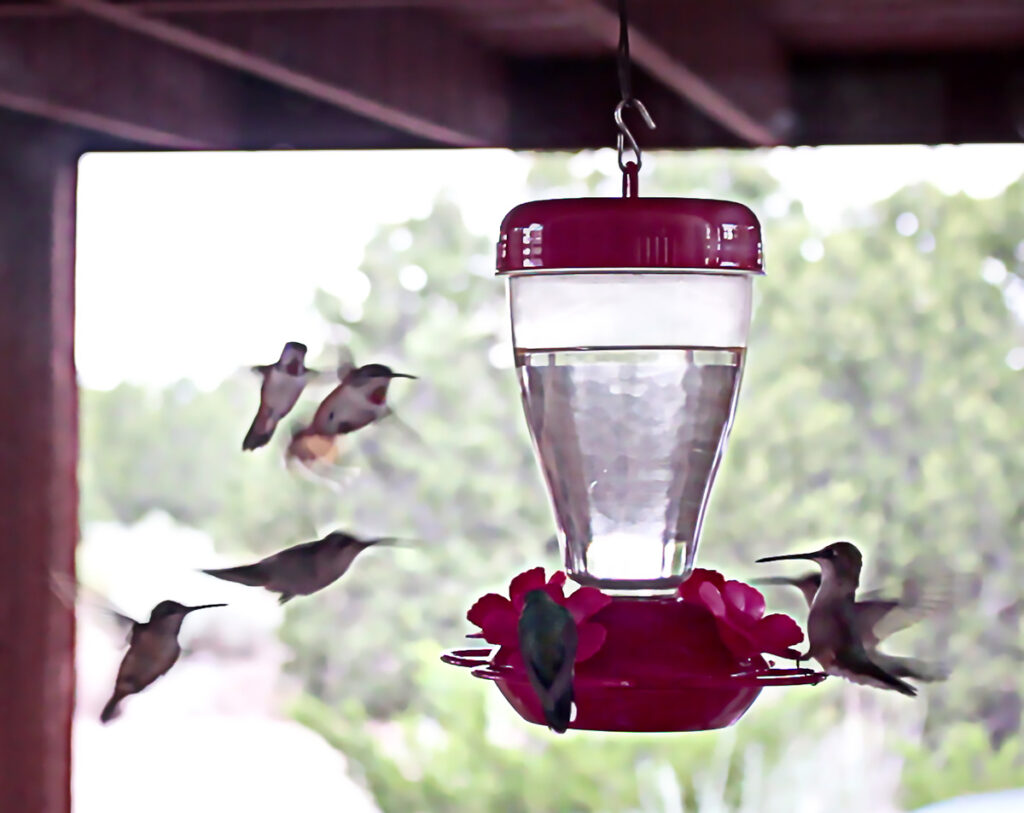
By BRYCE FLANAGAN
As spring turns to summer, we will see more and more hummingbirds visiting outdoor feeders as they migrate north. These tiny, shimmering beauties aren’t just natural wonders, they also play a crucial role in our global ecosystem and food supply by acting as pollinators. Unfortunately, their populations are being threatened by harmful pesticide use and monoculture agriculture across the hemisphere. But there are a wide range of actions we can take to help mitigate these effects and provide a reprieve to hummingbirds on their long journey.
Hummingbird feeders are a great help to weary travelers, but it’s important to keep a few things in mind to prevent doing more harm than good. Jenna McCullough, a graduate student studying ornithology at UNM, recommends using a mixture of 1 part cane sugar to 4 parts water, shaken in a large water bottle to dissolve. While red is attractive to hummingbirds, don’t use any dye in the mixture as it is toxic to their fragile stomachs and can poison them. Instead, use ribbons or non-toxic paint on the glass of your feeder to draw in more visitors, or consider gluing on fake flowers. Keep your sugar mixture refrigerated to extend its life, and change out feeders frequently, about every third day when temperatures are cooler—every day when it gets hot. You can tell the feeder needs to be changed when the sugar water becomes cloudy: this is a sign of mold and can poison hummingbirds.
Keeping cats indoors is one of the most important preventive steps you can take for all local bird populations, including hummingbirds. McCullough stresses the importance of this: “Free ranging cats have shorter life spans, can bring disease into your home, and have a significant, measurable impact on bird populations; I like to say ‘It’s safer for your cat, for you, and for our birds to keep cats inside.’” She suggests using a “catio,” a small enclosed space that allows cats to enjoy the fresh air without impacting local bird life or contracting parasites.
When you’re landscaping or planting new flora, consider using native shrubs that buffer against heavy winds and provide shelter for hummers and other pollinators. The New Mexico Locust and Chokecherry Tree provide shelter and attract other pollinators. Lavender or Apache Plume can provide dense cover that’s low to the ground. Hummingbirds’ favorite perennial flowers are whole leaf Indian Paintbrush, Giant Hyssop, Scarlet Gilia, and Blue Beardtongue (a.k.a. Penstemon).
For a relaxing local video of hummingbords feeding visit https://youtu.be/3vk3-iXY2jA.
Author
-

Bryce Flanagan moved from Sacramento, CA to Taos County in 2016, and has lived in Questa for two years. He's passionate about the unique and beautiful wildlife of our state and is a regular contributor to the Questa Del Rio News.
View all posts


